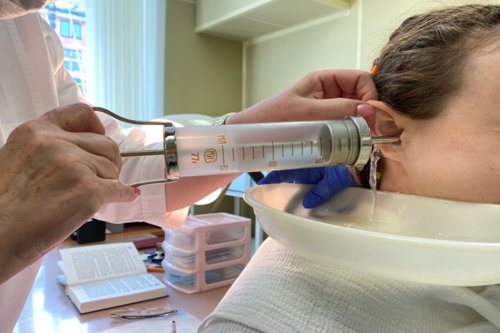Brain and ENT Clinic – Dr Lalit Mahajan In Nagpur & Dr Rachna Gangwani Mahajan In Nagpur
Ear Wax Removal in Nagpur

Ear Wax Removal in Nagpur is the process of safely and effectively removing excess ear wax from the ear canal.It is a natural substance produce by the glands in the ear to lubricate and protect the ear canal. Under normal circumstances, the wax gradually moves from the ear canal to the opening of the ear.thus, where it dries up and falls out.
However, in some cases, ear wax can accumulate and become impacted, causing symptoms such as hearing loss, and earache. Similarly, tinnitus (ringing in the ears), dizziness, or a feeling of fullness in the ear. When these symptoms occur due to excessive ear wax, it may be necessary to remove the wax.
Common Methods for Ear Wax Removal:
Ear Drops: Over-the-counter ear drops can be use to soften the wax, making it easier to remove. These drops typically contain mineral oil, hydrogen peroxide, or other ear wax softening agents. It’s essential to follow the instructions provide with the drops.
Irrigation: This method involves using a bulb syringe or a specialize ear irrigation kit to flush warm water thus, the ear canal, helping to dislodge and remove the softener ear wax. This procedure is often performed by a healthcare professional.
Manual Removal: A healthcare professional, such as an ear, nose, and throat (ENT) specialist, may use specialize instruments, such as a curette or suction device, to manually remove impact ear wax. This is typically done under direct visualization with an otoscope.
Microsuction: Microsuction is a procedure perform by healthcare professionals using a suction device with a fine, thin tube to gently remove ear wax. It is considere safe and effective for removing impact wax without the use of water.
Ear Candling: Ear candling is a controversial practice that involves inserting a hollow candle into the ear and lighting it. The theory is that the heat creates a vacuum that draws out ear wax. However, there is limit scientific evidence supporting the effectiveness of ear candling, and it carries potential risks. It is not recommende as a safe or reliable method for ear wax removal.
Treatment of ear wax removal
Improve Hearing: Thus, One of the primary goals of ear wax removal is to improve hearing, especially if hearing loss was cause by impacte wax blocking the ear canal.
Relief from Earache: Once, If ear wax removal is performed to address earache or discomfort caused by impact wax, individuals may experience relief after the procedure.
Reduce Tinnitus (Ringing in the Ears): Firstly, Tinnitus, or the perception of ringing or buzzing in the ears, may be alleviate when excessive ear wax is remove.
Resolution of Dizziness or Vertigo: Impact ear wax can sometimes contribute to feelings of dizziness or vertigo. Removing the wax may help resolve these symptoms.
Clearing of Ear Fullness: People often report a sensation of fullness or blockage in the ear when wax is impact. Ear wax removal can relieve this feeling.
Symptoms of ear wax removal
Ear, Nose, and Throat (ENT) Specialist: If home remedies are not effective or if you experience symptoms like hearing loss, tinnitus, dizziness, or ear pain, consult with an ENT specialist. They can use specialize instruments to safely remove impacte ear wax.
Microsuction: This is a procedure performe by healthcare professionals using a suction device with a fine, thin tube to gently remove ear wax. It is consider safe and effective for removing impacte wax without the use of water.
Manual Removal: A healthcare professional, such as an ENT specialist or a primary care physician, may use specialize instruments like a curette to manually remove impact ear wax. This is typically done under direct visualization with an otoscope.
Preventive Measures
Avoid Earwax Removal Tools: Do not use cotton swabs or other objects to clean the ear canal. This can push wax further down, risking impaction and potential damage to the ear.
Ear Hygiene: Gently clean the outer ear with a washcloth during regular bathing. This helps prevent the migration of wax toward the ear canal.
Ear Drops: Consider using over-the-counter ear drops containing mineral oil, baby oil, glycerin, or hydrogen peroxide to soften ear wax. Follow the instructions on the product.
